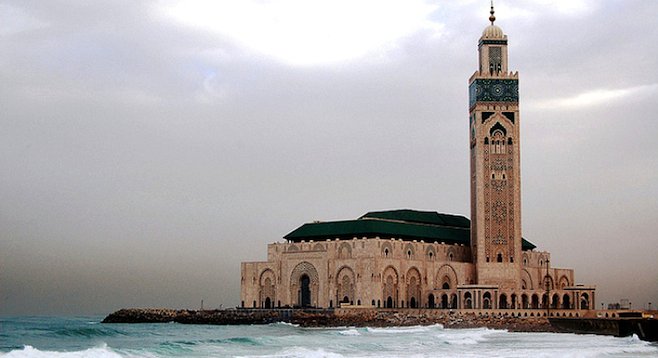 Facebook
Facebook
 X
X
 Instagram
Instagram
 TikTok
TikTok
 Youtube
Youtube

Many tourists visiting Morocco overlook the sprawling oceanfront city of Casablanca and instead head for more exotic cities such as Marrakech.
Morocco has retained its reputation of being the most stable country in North Africa, and unrest and protests have largely been avoided. With four million inhabitants, a stunning mix of art deco architecture, one of the world’s largest mosques, and picturesque beaches, the country’s bustling capital is a vibrant mix of old and new.
Casablanca’s elegant pedestrian Boulevard Mohammed V is reminiscent of art-deco-meets-Middle-Eastern style. A sleek French-built tram is scheduled to open for business by the end of 2012; as of now, you can merely stroll down the street admiring the 1930s-style buildings. Arrive early morning on the boulevard to experience the fresh produce and goods of the Central Market.
The French-designed neighborhood called the Habous greets you with elegant arches and whitewashed buildings. Its traditional ceramic and handicraft shops are popular with tourists, and locals shop here as well – so you know the quality of merchandise is better than other touristed areas.
You can’t leave Casablanca without seeing the gorgeous (and enormous) Hassan II Mosque, which looms above the crashing waves of the Atlantic Ocean. It has a retractable roof, and a laser on its minaret beams 35 kilometers in the direction of Mecca. Unlike most mosques, Hassan II allows non-Muslims inside on guided tours in the mornings and afternoons ($15/person).
On the city’s coast toward the Ain Diab area you’ll find the best beaches. The Anfa district holds hotels and nightclubs, and at the corniche – like a boardwalk – there are great beaches offering food & drink vendors as well as pony and horse rides. Bathing suits tend to be more modest than at Western beaches.
At the end of the beach, you’ll find the tomb of a holy man named Sidi Abdel Rahman, which is almost surrounded by water. Several families live in huts around the tomb.
Morocco’s first luxury mall looms just beyond the saint’s shrine a 10-minute walk away. Here you can see everything from Ralph Lauren to Christian Dior to an aquarium with sharks. The three-floor mall is always packed with Moroccan window shoppers, although the average person is unable to afford the items for sale.
If you really want to be a socially responsible traveler, visit the Solidarité Féminine Hammam, a health center and spa for women in the Quartier Palmier. It provides single mothers with job training and a source of income and helps improve their plight in Moroccan society. There are also two nearby restaurants serving typical Moroccan food where women are trained in culinary arts.
And, yes, you’ll even find Rick’s Café, named after the Humphrey Bogart movie Casablanca, in Casablanca's Old Medina. It’s not the original (which only existed on a movie set), but it is still popular with tourists.


Many tourists visiting Morocco overlook the sprawling oceanfront city of Casablanca and instead head for more exotic cities such as Marrakech.
Morocco has retained its reputation of being the most stable country in North Africa, and unrest and protests have largely been avoided. With four million inhabitants, a stunning mix of art deco architecture, one of the world’s largest mosques, and picturesque beaches, the country’s bustling capital is a vibrant mix of old and new.
Casablanca’s elegant pedestrian Boulevard Mohammed V is reminiscent of art-deco-meets-Middle-Eastern style. A sleek French-built tram is scheduled to open for business by the end of 2012; as of now, you can merely stroll down the street admiring the 1930s-style buildings. Arrive early morning on the boulevard to experience the fresh produce and goods of the Central Market.
The French-designed neighborhood called the Habous greets you with elegant arches and whitewashed buildings. Its traditional ceramic and handicraft shops are popular with tourists, and locals shop here as well – so you know the quality of merchandise is better than other touristed areas.
You can’t leave Casablanca without seeing the gorgeous (and enormous) Hassan II Mosque, which looms above the crashing waves of the Atlantic Ocean. It has a retractable roof, and a laser on its minaret beams 35 kilometers in the direction of Mecca. Unlike most mosques, Hassan II allows non-Muslims inside on guided tours in the mornings and afternoons ($15/person).
On the city’s coast toward the Ain Diab area you’ll find the best beaches. The Anfa district holds hotels and nightclubs, and at the corniche – like a boardwalk – there are great beaches offering food & drink vendors as well as pony and horse rides. Bathing suits tend to be more modest than at Western beaches.
At the end of the beach, you’ll find the tomb of a holy man named Sidi Abdel Rahman, which is almost surrounded by water. Several families live in huts around the tomb.
Morocco’s first luxury mall looms just beyond the saint’s shrine a 10-minute walk away. Here you can see everything from Ralph Lauren to Christian Dior to an aquarium with sharks. The three-floor mall is always packed with Moroccan window shoppers, although the average person is unable to afford the items for sale.
If you really want to be a socially responsible traveler, visit the Solidarité Féminine Hammam, a health center and spa for women in the Quartier Palmier. It provides single mothers with job training and a source of income and helps improve their plight in Moroccan society. There are also two nearby restaurants serving typical Moroccan food where women are trained in culinary arts.
And, yes, you’ll even find Rick’s Café, named after the Humphrey Bogart movie Casablanca, in Casablanca's Old Medina. It’s not the original (which only existed on a movie set), but it is still popular with tourists.
Comments